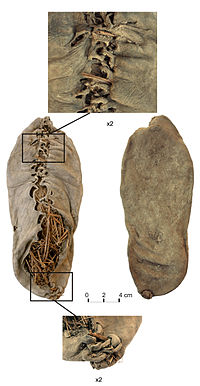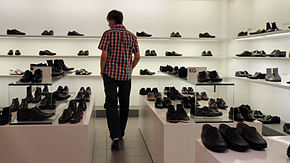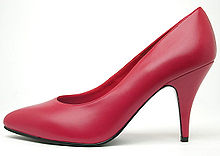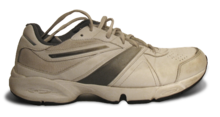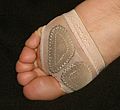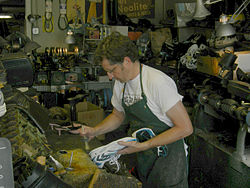- Shoe
-
This article is about footwear. For other uses, see Shoe (disambiguation).
A shoe is an item of footwear intended to protect and comfort the human foot while doing various activities. Shoes are also used as an item of decoration. The design of shoes has varied enormously through time and from culture to culture, with appearance originally being tied to function. Additionally fashion has often dictated many design elements, such as whether shoes have very high heels or flat ones. Contemporary footwear varies widely in style, complexity and cost. Basic sandals may consist of only a thin sole and simple strap. High fashion shoes may be made of very expensive materials in complex construction and sell for thousands of dollars a pair. Other shoes are for very specific purposes, such as boots specially designed for mountaineering or skiing.
Shoes have traditionally been made from leather, wood or canvas, but are increasingly made from rubber, plastics, and other petrochemical-derived materials.
Until recent years,[when?] shoes were not worn by most of the world's population—largely because they could not afford them. Only with the advent of mass production, making shoes available very cheaply, has shoe-wearing become predominant.
The foot contains more bones than any other single part of the body. Though it has evolved over hundreds of thousands of years in relation to vastly varied terrain and climate conditions, the foot is still vulnerable to environmental hazards such as sharp rocks and hot ground, which shoes can protect against.
Contents
History
The earliest known shoes are sandals dating from about 8000 to 7000 BC and found in Oregon, USA in 1938.[1] The world's oldest leather shoe, made from a single piece of cowhide laced with a leather cord along seams at the front and back, was found in a cave in Armenia in 2008 and is believed to date to 3,500 BC.[2][3][4] Ötzi the Iceman's shoes, dating to 3,300 BC, featured brown bearskin bases, deerskin side panels, and a bark-string net, which pulled tight around the foot.[3] However, tanned leather, the material most commonly used for making shoes, does not normally last for thousands of years, so shoes were probably in use long before this. Physical anthropologist Erik Trinkaus believes he has found evidence that the use of shoes began in the period between about 40,000 and 26,000 years ago, based on the fact that the thickness of the bones of the toes (other than the big toe) decreased during this period, on the premise that wearing shoes resulted in less bone growth, resulting in shorter, thinner toes.[5][6] The earliest designs were simple affairs, often mere "foot bags" of leather to protect the feet from rocks, debris, and cold. Since shoes use more leather than sandals, their use was more common in cold climates. By the Middle Ages, turn-shoes had been developed with toggled flaps or drawstrings to tighten the leather around the foot for a better fit. As Europe gained in wealth and power, fancy shoes became status symbols. Toes became long and pointed, often to ridiculous proportions. Artisans created unique footwear for rich patrons, and new styles developed. Eventually the modern shoe, with a sewn-on sole, was devised. Since the 17th century, most leather shoes have used a sewn-on sole. This remains the standard for finer-quality dress shoes today. Until around 1800, shoes were made without differentiation for the left or right foot. Such shoes are now referred to as "straights".[citation needed] Only gradually did the modern foot-specific shoe become standard.
Since the mid-20th Century, advances in rubber, plastics, synthetic cloth, and industrial adhesives have allowed manufacturers to create shoes that stray considerably from traditional crafting techniques. Leather, which had been the primary material in earlier styles, has remained standard in expensive dress shoes, but athletic shoes often have little or no real leather. Soles, which were once laboriously hand-stitched on, are now more often machine stitched or simply glued on.
Parts
Sole
The bottom of a shoe, the part that is intended to come in repeated contact with the ground, is called the sole. Soles have been made from plant fibers, leather, wood, rubber, synthetics, plastic, and various combinations of these materials. Soles can be simple, a single material in a single layer, or they can be complex with multiple structures or layers and materials.
Insole
See also: Shoe insert and Arch supportThe insole is the interior bottom of a shoe, which sits directly beneath the foot under the footbed (also known as sock liner). The purpose of insole is to attach to the lasting margin of the upper, which is wrapped around the last during the closing of the shoe during the lasting operation. Insoles are usually made of cellulosic paper board or synthetic non woven insole board. Many shoes have removable and replaceable footbeds. Extra cushioning is often added for comfort (to control the shape, moisture, or smell of the shoe) or health reasons (to help deal with defects in the natural shape of the foot or positioning of the foot during standing or walking). Basically, this is a main part of shoes which can absorb foot sweat. Footbeds should typically use foam cushioning sheets like latex and EVA, which provide good wearing comfort of the shoe.
Outsole
The outsole is the layer in direct contact with the ground. Dress shoes often have leather or resin rubber outsoles; casual or work-oriented shoes have outsoles made of natural rubber or a synthetic material like Polyurethane. The outsole may comprise a single piece, or may be an assembly of separate pieces of different materials. Often the heel of the sole has a rubber plate for durability and traction, while the front is leather for style. Specialized shoes will often have modifications on this design: athletic or so called cleated shoes like soccer, rugby, baseball and golf shoes have spikes embedded in the outsole to grip the ground.
Midsole
The layer in between the outsole and the insole that is typically there for shock absorption. Some types of shoes, like running shoes, have another material for shock absorption, usually beneath the heel of the foot, where one puts the most pressure down. Different companies use different materials for the midsoles of their shoes. Some shoes may not have a midsole at all.
Heel
The bottom rear part of a shoe is the heel. Its function is to support the heel of the foot. They are often made of the same material as the sole of the shoe. This part can be high for fashion or to make the person look taller, or flat for a more practical and comfortable use.
Vamp/upper
Every shoe has an upper part that helps hold the shoe onto the foot. In the simplest cases, such as sandals or flip-flops, this may be nothing more than a few straps for holding the sole in place. Closed footwear, such as boots, trainers and most men's shoes, will have a more complex upper. This part is often decorated or is made in a certain style to look attractive.
Lateral/medial
The outside part of the shoe is referred to as the lateral and the inside facing part of the shoe is the medial. This can be in reference to either the outsole or the vamp.
Welt
Main article: Welt (shoe)A welt is a strip of leather, rubber, or plastic that is stitched to the upper and insole of a shoe, as an attach-point for the sole.
Accessories
- Shoehorn: can be used to insert a foot into a shoe by keeping the shoe open and providing a smooth surface for the foot to slide upon.
- Shoe tree: placed inside the shoe when user is not wearing it, to help maintain the shoe's shape.
- Heel grip: used to prevent the shoe from slipping on the heel if the fit is not perfect
- Foam tap: a small foam pad placed under the ball of the foot to push the foot up and back if the shoe is too loose.
- Shoe polishing equipment:
- Shoe polish: a waxy material spread on shoes to improve appearance and glossiness, and provide protection.
- Shoe brush and polishing cloth: used to apply polish to shoes.
- Overshoes or galoshes: a rubber covering placed over shoes for rain and snow protection.
- (Orthopedic) shoe insert: insert of various materials for cushioning, improved fit, or reduced abrasion. These include padding and inner linings. Inserts may also be used to correct foot problems.
- Shoe bag: a bag that protects shoes against damage when they are not being worn.
- Shoe stretcher: a tool for making a shoe longer or wider or for reducing discomfort in areas of a shoe.
- Snow shoe: a wooden or leather piece which increases the area of ground covered by the shoe.
- Shoelaces: a system used to secure shoes.
Types
Dress and casual
Dress shoes are characterized by smooth and supple leather uppers, leather soles, and narrow sleek figure. Casual shoes are characterized by sturdy leather uppers, non-leather outsoles, and wide profile.
Some designs of dress shoes can be worn by either gender. The majority of dress shoes have an upper covering, commonly made of leather, enclosing most of the lower foot, but not covering the ankles. This upper part of the shoe is often made without apertures or openings, but may also be made with openings or even itself consist of a series of straps, e.g. an open toe featured in women's shoes. Shoes with uppers made high to cover the ankles are also available; a shoe with the upper rising above the ankle is usually considered a boot but certain styles may be referred to as high-topped shoes or high-tops. Usually, a high-topped shoe is secured by laces or zippers, although some styles have elastic inserts to ease slipping the shoe on.
Men's
 This male dress shoe, known as a blucher, is distinguished by its open lacing.
This male dress shoe, known as a blucher, is distinguished by its open lacing.
Men's shoes can be categorized by how they are closed:
- Oxfords (also referred as "Balmorals"): the vamp has a V-shaped slit to which the laces are attached; also known as "closed lacing". The word "Oxford" is sometimes used by American clothing companies to market shoes that are not Balmorals, such as Blüchers.
- Blüchers (American), Derbys (British): the laces are tied to two pieces of leather independently attached to the vamp; also known as "open lacing" and is a step down in dressiness.
- Monk-straps: a buckle and strap instead of lacing
- Slip-ons: There are no lacings or fastenings. The popular loafers are part of this category, as well as less popular styles, such as elastic-sided shoes.
Men's shoes can also be decorated in various ways:
- Plain-toes: have a sleek appearance and no extra decorations on the vamp.
- Cap-toes: has an extra layer of leather that "caps" the toe. This is possibly the most popular decoration.
- Brogues (American: wing-tips): The toe of the shoe is covered with a perforated panel, the wing-tip, which extends down either side of the shoe. Brogues can be found in both balmoral and blucher styles, but are considered slightly less formal.
Formal high-end men's shoes are manufactured by several companies around the world, most notably in England, France, Italy, and America. Notable British brands include: Church's English Shoes (est. 1873), John Lobb Bootmaker (est. 1849), Edward Green Shoes (est. 1890), and Crockett & Jones (est. 1879). Both John Lobb and Edward Green offer bespoke products. In between the world wars, men's footware received significant innovation and design, led by cobblers and cordwainers in London's West End.[7] The most notable French product is made by J.M. Weston. Armani of Italy was a major influence on men's shoe design in the 1960s-1980s until they returned to the larger proportions of its forebears, the welt-constructed Anglo-American dress shoe originally created in Edwardian England. Another well-known Italian company is Salvatore Ferragamo Italia S.p.A.. The remaining elite American companies are Allen Edmonds and Alden Shoe Company. Alden, located in New England, specializes in genuine shell cordovan leather from the only remaining horse tannery in America (Chicago)[8] and is completely manufactured in America, whereas Allen Edmonds, of Wisconsin, is a larger company that outsources some of its production.[9]
Women's
There is a large variety of shoes available for women, in addition to most of the men's styles being more accepted as unisex. Some broad categories are:
- High-heeled footwear is footwear that raises the heels, typically 2 inches (5 cm) or more above the toes, commonly worn by women for formal occasions or social outings. Variants include kitten heels (typically 1½-2 inches high) and stilletto heels (with a very narrow heel post) and wedge heels (with a wedge-shaped sole rather than a heel post).
- Sneaker boot or sneaker pump: a shoe that looks like an athletic shoe, but is equipped with a heel, making it a kind of novelty dress shoe.
- Mules are shoes or slippers with no fitting around the heel (i.e. they are backless)
- Slingbacks are shoes which are secured by a strap behind the heel, rather than over the top of the foot.
- Ballet flats, known in the UK as ballerinas, ballet pumps or skimmers, are shoes with a very low heel and a relatively short vamp, exposing much of the instep. They are popular for warm-weather wear, and may be seen as more comfortable than shoes with a higher heel.
- Court shoes, known in the US as pumps, are typically high-heeled, slip-on dress shoes.
Unisex
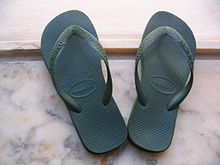 The flip-flop sandal, worn both by men and women
The flip-flop sandal, worn both by men and women
- Clog
- Platform shoe: shoe with very thick soles and heels
- Moccasin: originated by Native Americans, a soft shoe without a heel and usually made of leather.
- Sandals: open shoes consisting of a sole and various straps, leaving much of the foot exposed to air. They are thus popular for warm-weather wear, because they let the foot be cooler than a closed-toed shoe would.
- Espadrilles are casual flat warm-weather shoes of a style which originated in the Pyrenees. They usually have a cotton or canvas upper and a flexible sole of rope or rubber. There are high-heeled versions for women.
- Saddle shoe: leather shoe with a contrasting saddle-shaped band over the instep, typically white uppers with black "saddle".
- Slip-on shoe: a dress or casual shoe without laces; often with tassels, buckles, or coin-holders (penny loafers).
- Boat shoes, also known as "deck shoes": similar to a loafer, but more casual. Laces are usually simple leather with no frills. Typically made of leather and featuring a soft white sole to avoid marring or scratching a boat deck. The first boat shoe was invented in 1935 by Paul Sperry.
- Boots: Long shoes (covering the ankle) frequently made of leather. Some are designed to be used in times of bad weather, or simply as an alternate style of casual or dress wear. Styles include rubber boots and snow boots, as well as work boots and hiking boots.
- Slippers: For indoor use, commonly worn with pajamas.
- Vibram FiveFingers, meant to simulate the "natural" experience of going barefoot, while protecting the foot
- Sneakers or Canvas shoes
Athletic
Men's and women's athletic shoes and special function shoes often have less difference between the sexes than in dress shoes. In many cases these shoes can be worn by either sex. Emphasis tends to be more on function than style.
- Running shoes: very similar to above, with additional emphasis on cushioning.
- Track spikes: lightweight; often with plastic or metal cleats
- Cleat (shoe): a type of shoe featuring molded or removable studs. Usually worn while playing sports such as rugby, football, American football, or baseball.
- Golf shoes: with "spikes" for better grip in grass and wet ground. Originally the spikes or "cleats" were made of metal but replaceable "soft spikes" made of synthetic plastic-like materials with prongs distributed radially around the edge of each spike are much more common today (and are required on many golf courses since they cause less damage to the greens).
- Bowling shoes: intermediate style between ordinary dress shoes and athletic shoes. They have harder rubber soles/heels so as not to damage bowling alley floors. They are often rented or loaned at bowling alleys.
- Climbing shoes: a shoe designed for rock climbing. They typically have a close fit, little if any padding, and a smooth sticky rubber sole with an extended rubber rand.
- Hiking shoes or boots: usually have a high somewhat stiff upper with many lace eyelets, to provide ankle support on uneven terrain, with extra large traction on the sole.
- Walking shoes: have a more flexible sole than the running shoe, lighter in weight than the hiking boot, may have air holes, may not be water proof.
- Skating shoes: typically called skates. They have various attachments for skating on the bottom of the shoe portion.
- Ski boot: a large, thick plastic boot specially designed for attachment to the ski.
- Skate shoes: specifically designed for use in Skateboarding, the shoes are manufactured with flat soles as to allow a skateboarder to have better grip when riding a skateboard. They are very wide and have extra layers of padding to protect the skateboarders feet.
- Cycling shoes are equipped with a metal or plastic cleat to interface with clipless pedals, as well as a stiff sole to maximize power transfer and support the foot.
- Snowshoes are special shoes for walking in thick snow. In temperate climates, snowshoes are used for mostly recreational purposes in winter.
- Wrestling shoes are light, flexible shoes that mimic bare feet while providing additional traction and protection.
Orthopedic
Orthopedic or "comfort" shoes are made with pedorthic and anatomically-correct comfort qualities, such as padded removable footbeds, wide toe boxes and arch support are made especially for those with problematic feet.
Dance
- Pointe shoes are designed for ballet dancing. These have a toe box that is stiffened with glue and a hardened sole so the dancer can stand on the tips of their toes. They are secured by elastic straps and ribbons that are tied to the dancer's ankles.
- Ballet shoes are soft, highly pliable shoes made of canvas or leather, with either continuous or two-part sole (also called split-sole). The sole is typically made of leather, with thicker material under the ball and heel of the foot, and thinner and thus more flexible material under the arch so that the foot can be pointed to its utmost. Ballet slippers are usually secured by elastics that cross over the top of the foot. They are most commonly pink, white, black, or pale tan, although they may be made in specialty colours such as red or blue.
- Ghillies are soft shoes that are used in Irish dance, Scottish country dance, and highland dance.
- Jazz shoes typically have a two-part, rubberized sole (also called split-sole) to provide both flexibility and traction, and a low (one inch or shorter) heel. They are secured to the foot by laces or elastic inserts.
- Tango and Flamenco shoes are used for dancing the tango or flamenco.
- Ballroom shoes fall into two categories: Ballroom and Latin American. Both are characterised by suede soles. Men's ballroom shoes are typically lace-ups with one-inch heels and patent leather uppers. Ladies' ballroom shoes are typically court shoes with two-inch heels, made of fabric that can be colored to match the dancer's dress. In contrast to the low Ballroom heel, which evenly distributes weight across the foot, Latin American shoes have higher heels designed to shift weight onto the toes. Latin shoes are also more flexible than ballroom shoes. Men's Latin shoes typically have 1.5- to 2-inch high, shaped heels, while Ladies' Latin shoes have 2,5-inch to 3-inch heels. Ladies shoes are typically open-toed and strapped.
- Dance sneakers. Also known as dansneakers, these are a combination of a sneaker and a dance shoe, with a reinforced rubber toe.
- Character shoes have a one to three inch heel, which is usually made of leather, and often have one or more straps across the instep to secure it to the foot. They may come in soft-soled (suede) or hard-soled varieties. They may be converted to tap shoes by attaching taps.
- Foot thongs are known by various names depending on the manufacturer, including dance paws, foot undies, and foot paws. They are slip-on, partial foot covers that protect the ball of a dancer's foot from skin abrasions while executing turns. From a distance, flesh colored foot thongs give a dancer the appearance of having bare feet.
- Tap shoes have metal plates mounted to the bottoms of the toe and heel. The metal plates, which are known as taps, make a loud sound when struck against a hard performance surface. Tap shoes, which are used in tap dancing, may be made from any style of shoe to which taps can be attached.
-
Jazz shoes. This style is frequently worn by acro dancers
Work
Work shoes are designed to stand heavy wear, to protect the wearer, and provide high traction. They are generally made from sturdy leather uppers and non-leather outsoles. Sometimes they are used for uniforms or comfort by nurses, waitresses, police, military personnel, etc. They are commonly used for protection in industrial settings, construction, mining, and other workplaces. Protective features may include steel-tipped toes and soles or ankle guards.
Minimalist
Minimalist shoes are shoes that are minimal in design so that the advantages of walking/running barefoot are incorporated, yet without dropping additional protection of the foot from sharp objects. Minimalist shoes include: Vibram FiveFingers, MBT, Nike Free
Historical
Shoes of the past include:
- Turn-shoes: a method by which the shoe is constructed inside-out, wetted, and turned — the finished side of the leather flipped to the outside. Such footwear was common from the Middle-ages until modern shoes were developed in the Tudor era. Because of their construction, turn-shoes cannot simply be re-soled, unlike most modern shoe types.
- Espadrilles: these sandals, which are still worn today, are found as early as the 14th century.
- Patten: a European wooden overshoe used to keep a person's feet dry outdoors. First worn in the middle ages, they continued in use even into the early 20th century. Peoples such as the Dutch, Flemings, and some French carved similar, fully enclosed wooden shoes.
- Poulaine: a shoe with a long-pointed toe, popular in Europe in the 15th century.
- Moccasins: the historical shoe of many North American Indian tribes.
Collection
Athletic sneaker collection has existed as a part of urban subculture in the United States for several decades.[10] Recent decades have seen this trend spread to European nations such as the Czech Republic.[11] A Sneakerhead is a person who owns multiple pairs of shoes as a form of collection and fashion. A contributor to the growth of sneaker collecting is the continued worldwide popularity of the Air Jordan line of sneakers designed by Nike for Basketball star Michael Jordan.
Maintenance
- Breaking-in: some shoes are made of hard but deformable material. After a person wears them multiple times, the material reforms to fit the wearer's feet. The person is said to have broken in the shoes.
- Polishing: for protection, water resistance (to some extent) and appearance, especially for leather shoes and boots.
- Heel replacement: heels periodically wear out. Not all shoes are designed to enable this.
- Sanitization: the inside of shoes can be sanitized with germicidal shoe trees or other cleansing methods to prevent the growth of microorganisms such as odor-causing bacteria or fungi.[12]
- Sole replacement: soles can also wear out. Not all shoes can have their soles replaced.
- Shoelace replacement: shoelaces can sometimes be damaged or destroyed necessitating the replacement of the laces.
- When unfit for use, shoes can be treated as trash or municipal solid waste and disposed of. The exception can be with most athletic sneakers which can be recycled and turned into other raw materials. See Nike Grind as an example.
Someone who makes or repairs shoes in a shop is called a cobbler.
Biodegradability
Due to the appearance of new man-made materials, shoes have become increasingly less biodegradable. Currently, mass-produced shoes generally require 1000 years to degrade, and/or may not degrade at all, depending on the types of material employed in the production of the shoe. Recently some shoemakers have picked up on the issue and are beginning to produce shoes made entirely from degradable materials, such as Nike Considered.[13][14]
Etiquette
See also: Dress codeIn the Middle East, parts of Africa, Korea and Thailand, it is considered rude to show the soles of the feet to others (even accidentally, such as by crossing the legs). Shoe throwing is a great insult in some areas in the Middle East and in India.[15] In addition, in Thailand, it is an extreme insult for the foot, socks, or shoes to touch someone's head or be placed over it.
In literature
Shoes play an important role in the fairy tales Cinderella, The Wonderful Wizard of Oz and The Red Shoes. In literature and film, an empty shoe or a pair of shoes signifies death.[citation needed]
Sizes
Main article: Shoe size- Units for shoe sizes vary widely around the world. European sizes are measured in Paris Points, which are worth two-thirds of a centimetre. The UK and American units are approximately one-quarter of an inch, starting at 8¼ inches.[citation needed] Men's and women's shoe sizes often have different scales. Shoes size is often measured using a Brannock Device, which can determine both the width and length of the foot.
Companies
See the category shoe companies for a list of shoe companies.
See also
- Runner's toe, injury from malfitting shoes
- Locomotor effects of shoes
- Foot binding
- Shoe tossing
References
- ^ Fort Rock Sandals
- ^ "World's oldest leather shoe found in Armenia". Reuters. June 10, 2010. http://www.nationalpost.com/todays-paper/World+oldest+leather+shoe+found+Armenia/3136011/story.html. Retrieved June 13, 2010.[dead link]
- ^ a b Ravilious, Kate (June 9, 2010). "World's Oldest Leather Shoe Found—Stunningly Preserved". National Geographic. http://news.nationalgeographic.com/news/2010/06/100609-worlds-oldest-leather-shoe-armenia-science/. Retrieved June 13, 2010.
- ^ Petraglia, Michael D.; Pinhasi R, Gasparian B, Areshian G, Zardaryan D, Smith A et al. (2010). "First Direct Evidence of Chalcolithic Footwear from the Near Eastern Highlands". PLoS ONE 5: e10984. doi:10.1371/journal.pone.0010984. http://www.plosone.org/article/info%3Adoi%2F10.1371%2Fjournal.pone.0010984. Reported in (among others) Belluck, Pam (9 June 2010). "This Shoe Had Prada Beat by 5,500 Years". New York Times. http://www.nytimes.com/2010/06/10/science/10shoe.html. Retrieved 11 June 2010.
- ^ BBC.co.uk
- ^ Trinkaus E,Shang H. (2008). Anatomical evidence for the antiquity of human footwear: Tianyuan and Sunghir. Journal of Archaeological Science 35 (2008) 1928-1933. doi:10.1016/j.jas.2007.12.002
- ^ Flusser, Alan. "Dressing the Man" Harper Collins, 2002, pg 189.
- ^ http://blog.leffot.com/2008/08/16/shannon-in-cordovan/
- ^ http://www.askandyaboutclothes.com/Tutorials/JCuseyOnShoes.htm
- ^ Skidmore, Sarah (15 January 2007). "Sneakerheads Love to Show Off Their Shoes". The Washington Post. http://www.washingtonpost.com/wp-dyn/content/article/2007/01/14/AR2007011400451.html. Retrieved 2 July 2011.
- ^ "Czech 'Sneakerheads' Flaunt Their Best Trainers". Czech Position. http://www.ceskapozice.cz/en/news/society/czech-%E2%80%98sneakerheads%E2%80%99-flaunt-their-best-trainers. Retrieved 2 July 2011.
- ^ Sterishoe.com, Accepted by the American Podiatric Medical Association
- ^ Brooks BioMoGo running shoe
- ^ Simple Shoes Bio-D
- ^ Hartford Courant
Further reading
- History of footwear in Norway, Sweden and Finland : prehistory to 1950, ISBN 91-7402-323-3
- Patrick Cox: Wit, Irony, and Footwear, Tamasin Doe (1998) ISBN 0-8230-1148-8
- A Century of Shoes: Icons of Style in the 20th Century, Angela Pattison ISBN 0-7858-0835-3
External links
- Footwear History
- International Shoe Size Conversion Charts, from i18nguy's website, offers more information.
- Shoe Care
- The Political History of Shoes
- ShoeGuide.Org, A footwear encyclopedia
Footwear Men's dress shoes Brogues · Derbies · Loafers · Court shoes · Monks · Oxfords · Spectator shoes (Co-respondent shoes) · Venetian style shoes · Winklepickers · Brothel creepersWomen's dress shoes Ballet flats · Court shoes (Pumps) · Loafers · Slingbacks · Mules · Mary Janes · Mojari · Saddle shoes · Venetian style shoes · WinklepickersOther shoes Clog · Espadrilles · Flip-flops · Galoshes · Geta · Giveh · Moccasins · Platform shoes · Sandals · Slides · Slippers · VeldskoensMilitary footwear Ammunition boots · Cold weather boots · Combat boots · Jackboots · Jump boots · Jungle boots · Tactical boots · Tanker boots · Trench bootsSport-related footwear Fashion boots Work boots/shoes Australian work boots · Chukka boot · Cowboy boot · Hip boot · Rigger boot · Steel toe boots · Waders · Engineer bootsOther boots Historical Categories:- Footwear
- Shoes
Wikimedia Foundation. 2010.


